Ingemar Borelius
From the very beginning, in the early nineteen hundred, the different Retriever types were looked upon as varieties of one common Retriever breed, although - types varied at a time where there were no dog clubs setting breed standards or shows to confirm. These dogs were bred for a specific purpose, to retrieve at larger shots, constituting a conformation which was not that unlike a modern working retriever. The common and dominating heritage from the Canadian working water dog, called the St Johns dog, the Newfoundland dog or Labrador dog, due to its original birthplaces, made looks quite even although color and coat structure varied a lot. It’s a well-known fact that these dogs were quite freely and openly crossed.
From Cassell’s “illustrated Book of the Dog
When the Retrievers were taken to the first dog shows they were presented in different classes due to its looks and it’s been said that littermates from the very same litter were sometimes shown under different flags, being flat coated or smooth coated retrievers. When the British Kennel Club (KC) was established in 1873, initiated by the Flatcoat breeder, Mr. Sewallis Shirley, and dog shows became organized in a more formal manner this was still the case. There was one Retriever and the varieties were marked with suffixes like Retriever (wavy coated), Retriever (curly coated), Retriever (flat coated), Retriever (smooth coated), etc. The Flat Coated and Curly Coated varieties were the first ones to be recognized as independent breeds, being followed in 1903 by the Labrador Retriever and in 1911 by the Golden Retriever. The Kennel Club responded rapidly setting up a new registry for Interbreds and a rule saying that Interbreds were allowed to compete at trials but not at dog shows. For inclusion on the pure breed register, the cross needed to be a minimum of three generations back. This option was kept until 1970 when the last interbred retrievers were registered with the KC. I’m sure there were good reasons for this discontinuation but I believe it must have been mainly in the interest of the show breeders. If we knew what we know today about the strong negative consequences of narrowing gene pools I presume the decision might have been a different one.
But mixes were still allowed and one of the most well-known cases appeared in 1916 when Horton Max, being a three quarter Flatcoat and one quarter Labrador, won two CC’s in the Labrador ring, being a very typical Labrador according to the current fashion. The Labrador historian Richard Edwards says in an email that his win generated strong reactions among the most influential Labrador breeders and actions were taken to push for firmer rules with good support from the leading Flatcoated and Golden breeders.
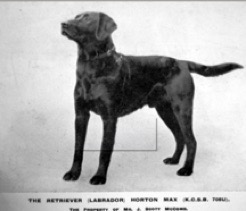
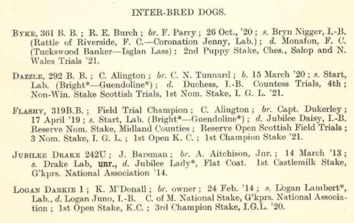
Stud Book & Record of Field Trials for Retrievers 1899-1922. Byke was a full sibling of the Interbred bitch Bibby who contributed immensely to the working Flatcoat strains.
The Kennel Club responded rapidly setting up a new registry for Interbreds and a rule saying that Interbreds were allowed to compete at trials but not at dog shows. For inclusion on the pure breed register, the cross needed to be a minimum of three generations back. This option was kept until 1970 when the last interbred retrievers were registered with the KC. I’m sure there were good reasons for this discontinuation but I believe it must have been mainly in the interest of the show breeders. If we knew what we know today about the strong negative consequences of narrowing gene pools I presume the decision might have been a different one.
According to Ciara Farrell at the British Kennel Club” the registration of dogs from unregistered, pure or crossbred parents has, strictly speaking, never been abolished and such dogs may still be registered under certain circumstances as directed by the General Committee of the British Kennel Club. This is outlined in the Kennel Club Regulation (B.2.c). In practice this is only applied on new breeds on the import register where it may be impossible to verify overseas breeding. Outside of the import register the only circumstances in which the General Committee may consider sanctioning a cross-mating would be to address a specific inherited health problem. This has never happened in the modern era and regarding retrievers, with the last sanctioned interbred registrations taking place in 1970, there wouldn’t be any circumstances in which a modern retriever would have a cross in the previous five generations.” According to the British Kennel Club these rules are for the breed register only – the activity register, for dogs involved in sport, is open to any dog regardless of ancestry. But I presume there are other rules or practices disqualifying Interbreds to be entered nowadays at Retriever Field Trials. Mixes of Retrievers were called Interbreds and not Crossbreds, which is the more generic term for mixes used in the dog world. It indicated that these mixes were something else than just a cross but a mix between cousin breeds. It’s an interesting fact that Interbred prize winners were listed in the dog press alongside the established breeds and the registration data was regularly published in the Kennel Gazette under its own headline until 1970.
According to Richard Edwards the Labrador breed was originally” a working dog and not a show dogs in any sense. In the early twentieth century, the Flatcoats were dual purpose where most emphasis was put on good looks in relation to working ability. Within a few years, the Labs had taken over the field trials completely as they were simply far better than the Flatcoat. The Flatcoat people resorted to crossing into Lab lines to try to compete but the only Flatcoat that competed successfully with the Labs was the Flatcoated F.T. Champion Meeru, winning the Retriever Championship in 1912. But she looked like an overgrown spaniel and not like the handsome dual purpose Flatcoat that existed in the late nineteenth century. After that few Flatcoats had major wins in the field. Few if any of the Labrador people out crossed to Flatcoats, it was Flatcoat people using Labs. However, since most of the Interbreds were wanted for working there was not much concern regarding the Interbreds. Crossing Labradors with similar sized breeds tended to result in the offspring looking like Labradors, as one person wrote to the Field magazine. The Flatcoat breeders were by default spoiling/ending their breed since most of the offspring were being registered as Labradors.”
As Richard Edward says it was probably the case that most working breeders, having Interbreds, preferred to breed to working Labradors and register their offspring as Labradors. Pro work breeders, with no strong connections to the Flatcoat, went for the best worker where ever it could be found and in that context the best workers were working Labradors. Most Interbreds over the years (and they were quite a few) had minor impact on the main breeding stock. Interbreds were mainly produced for the benefit of their owners. Nevertheless, there are examples in all retriever breeds that interbreeding was done successfully to improve certain features. The fact that it broadened the genepools was a bonus that few people thought about at that time.
It’s a well-known fact in Flatcoat history that the Interbred Bibby had an immense impact on the working Flatcoat lines during the twenties and thirties as well as during the recreation years after the second world war. But less is known about the background of Pewcroft Plague being registered as a pure bred Flatcoat but with little doubt being an Interbred. The Plague story has a strong connection to the turbulence that appears now and then around the yellow Flatcoats. It was a bit of a problem during the sixties when the breed was starting to rise again after the severe decline during the nineteen-thirties and the second world war. Rumors told it was due to unknown Labrador or Golden crosses, and it was no doubt one of the reasons, although there has always existed a yellow gene in the Flatcoat strains. To try to find the yellow gene Nancy Laughton (Claverdon) made what seemed to be a” test mating” in 1962, a very close linebreeding to her own lines, producing the yellow Claverdon Blonde Caesar for Colin Wells (”W” and later Woodland). But I don’t believe her suspicions then were directed towards the branches back to Plague appearing behind that mating. At that time, she obviously thought it was hidden somewhere else in her lines. (For those of you who are curious about the US Flatcoat history C. Blonde Caesar was the sire of Witham who was imported by Sally Terroux and played a role in the early breed history).
As it seems the ageing O’Neill, who was hospitalized in 1967, wanted to ease his conscience about this matter. He wrote a letter to Joan Mason (Heronsflight), who cared for his last dogs, and told this story about Plague.
O’Neill had kept Flatcoats since the twenties but saw an alarming decline in Flatcoat bloodlines at the end of the thirties and he feared it was the end of the breed. In a typewritten copy of that letter provided by Joan Mason, O’Neill tells that he bought back a bitch named Pewcroft Pest whom had been sold as an adult many years before. He mated her to his own dog, Pewcroft Puzzler, but according to the letter O’Neill soon realized that he had obtained another bitch that must have been be a” more or less pure Labrador”. You should know that he’d bought Pest as an adult after having seen her litter mate doing quite well and probably winning the reserve CC at Crufts that year (in 1930 or 1931?). She came from good breeding being sired by the great Specialist. O’Neill heard that Pest was for sale quite cheap so he bought her and had a litter out of her.” But the more he saw of her the less he liked her” and she was given away. Eight years later, being aware of the narrowing Flatcoat bloodlines, he remembered Pest. He got her back, mated her, and kept the bitch Pewcroft Plague (born 22 March 1939) who, according to the O’Neill letter, was” one of the most remarkable workers he had ever known in any breed”.
When looking at the limited data that is available about Plague there is quite a” mysterious” notation that someone has made under her sire Pewcroft Puzzler in Flatcoatdata.com. He was mated to a Labrador bitch, Poppleton Black Tulip, to produce Pewcroft Prong being born the 10th of March 1939. According to the Kennel Gazette Pewcroft Prong was correctly registered as an Interbred in 1946 simultaneously with the registration of her daughter as an Interbred (sired by a working Labrador) and a granddaughter as a pure Labrador (sired by a working Labrador).

So according to the registration data, O’Neill used his dog Pewcroft Puzzler on Poppleton Black Tulip, to produce the interbred Pewcroft Prong being born the 10 March 1939 and on another bitch that in his own words was” a more or less pure Labrador” to produce Pewcroft Plague being born the 22 March 1939.
We should know that O’Neill was the most serious of breeders and whatever he did was for the welfare of the breed. But his story doesn’t sound right and I’m quite sure it isn’t correct.
- Yes, Pest came from quite good breeding but why try to get back an old bitch that he strongly disliked eight years ago?
- O’Neill was one of the greatest Flatcoat breeders of all times with a deeper knowledge about Flatcoat conformation than most other breeders who couldn’t mistake a” more or less pure Labrador” for a Flatcoat.
- If the” pseudo-Pest” was an Interbred from unknown breeding what were the options to get” one of the most remarkable workers he had known in any breed”?
- Having the choice (if there really was one?) between an interbred from one of the very best Labrador dual purpose lines at that time and an interbred out of an unknown” more or less pure bred Labrador”, why choose the second one as the foundation for his Flatcoat breeding?
There are further question marks around his actions! It sounds strange when he says that he’d realized that the pseudo-Pest was an Interbred but” the only pedigree he had was the original Pest pedigree” so he used that to register Plague as a pure bred. He could easily have registered her using the Interbred rules that were fully accepted at that time. But it might have been so that the quite small and narrowing Flatcoat fraternity had a negative attitude towards interbreeding as a breeding tool or it could be so that the owner of the bitch wouldn’t do this interbreeding openly. The (previous?) owner of Poppleton Black Tulip, the breeders Mr. and Mrs. Outhwaite, had at least two litters out of her of which one made its mark in the Labrador history.
We will probably never know for sure but I believe the following story sounds more plausible: O’Neill no doubt saw the rapidly narrowing Flatcoat bloodlines at the end of the nineteen-thirties. Being a wise and conscious man he feared the political turbulence that would soon initiate the second world war and he had good reasons to believe that the Flatcoat could become extinct due to the war. He had an option to use his excellent dog Pewcroft Puzzler (Dancer of Riverside x Atherbram Jet, by far being the most influential show combination during the pre-war period) on Poppleton Black Tulip being owned by the Outhwaite couple (Poppleton), a breeder who was open for experiments according to Richard Edvards. O’Neill kept the most Flatcoat alike bitch pup who “turned out to be the most remarkable worker he had ever known in any breed”. He used her to broaden the Flatcoat genepool and as a foundation bitch for his continuous breeding. I believe we will never know if the Outhwaite couple kept a litter mate to be used” sub rosa” in their Labrador lines?
The Interbred bitch (or her littermate) was mated to a working Labrador to produce Pewcroft Puss. She was born 2 October 1940 but registered January 1946 simultaneously with her mother being registered as Pewcroft Prong in the Interbred registry. In 1942, the same Interbred bitch (or her litter mate) had a litter with the Flatcoat Atherbram Warrior, bringing in two close new lines back to the Dancer of Riverside x Atherbram Jet combination. This time O’Neill did, for an unknown reason, choose to register the dam as the pure bred Flatcoat Pewcroft Plague and her daughter as Pewcroft Peg. There were no more litters registered out of Pewcroft Prong or Pewcroft Plague, probably being two different names on the very same bitch.
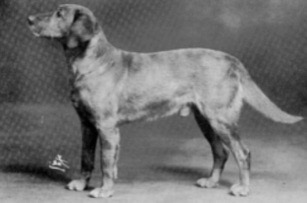
It’s notable that Poppleton Black Tulip came from the very best dual purpose bred Labrador lines. Her sire was a half-brother of Haylers Defender the very first yellow Labrador Field Trial Champion and he was the grandson of Dual Ch Banchory Bolo one of the great pillars of the early Labrador breed. The sire of the yellow Labrador Dual Champion Knaith Banjo, the very last retriever to gain a dual championship in 1949, was a Poppleton dog quite closely linebred to Poppleton Black Tulip and her littermate Ch Poppleton Black Lancer. It’s an interesting fact as well that interbreeding of vital importance was made in the Golden Retriever breed. The Labrador Haylers Defender was the maternal grandsire of Haulstone Larry the very first Golden to win the Retriever Championship at the end of the nineteen thirties.
Rickard Edvards states that ”I have no doubt that the Outhwaite couple (Poppleton) would be willing to try “experiments”. They “improved” the yellow Labradors by crossing them with Foxhounds in the 1940’s but they were registered as Labradors, I assume, with false pedigrees. That this was so could be seen in Labrador type as late as the 1980’s when obvious Foxhound characteristics could be seen in top winning show Labradors. I remember them well. Some of the most obvious hound character came down from the Scottish “Garshangan” kennel, very Poppleton influenced. Not all the hound character was negative, some of the lines of Labs from the outcross moved very true.
According to Richard Edwards there are some Interbreds behind Black Tulip as well and he states that one of the early Labrador champions, the well-known Ilderton Ben, was very” Flatcoat” in type”. Looking at pictures Ilderton Ben, no doubt, looked like a short haired Flatcoat but now we are back to the foundation years in the beginning of the previous century.
Colors other than black was non-desirable for Flatcoats as well as Labradors in the early days and it took a long time before they were fully accepted. According to Mary Roslyn-Williams, famous Labrador breeder, judge and book writer, Chesapeake Bay Retriever blood was used to improve the yellow and liver lines and the turned-back coats that appeared now and then in yellows and livers were probably ratifying that. Furthermore, the liver or chocolate color in Labradors was strengthened via Pointer crosses according to her, but with the negative consequence that heads were ugly and untypical. Following the same story a Flatcoat cross,” with one of the best sires of that day”, was used” sub rosa” to improve the heads of the chocolate Labradors.
I’m sure you are asking yourself if these early Flatcoat/Labrador crosses, these Interbreds, have that much to do with today’s Flatcoats? One odd Labrador producing one odd Interbred around 1939 what does that matter? When it comes to the Ponsbourne Flatcoats, offering a true outcross line with a quite strong working Labrador presence during the same period, I would say the influence on the main stock was quite limited. These dogs were used by the Claverdon, Westering and Wyndham kennels but their offspring didn’t play a significant role when the modern Flatcoat was created. When it comes to Plague and her offspring the picture is radically different. Plagues genes appear multiple times in all Flatcoats today and she had no doubt a massive impact on the post war Flatcoat when it came to working as well as show qualities and a broadening of the narrow genepool.
Again, Pewcroft Plague and her offspring in coming generations were repeatedly line bred to the Dancer X Jet combination. In the second generation, an outcross line was added to the top working lines of the nineteen thirties with multiple lines back to the Interbred Bibby. The few litters that came out of Plague’s children and grandchildren played a key role in the foundation stock for the post war Flatcoat. Even if Nancy Laughton’s Claverdon Jet and Colin Wells Waterman and their descendants played key roles as well when the breed was recreated after the war, it’s no doubt that the Pewcroft dogs had a similar impact. Nancy Laughton used several Pewcroft dogs at stud, Read Flowers (Fenrivers), Amelia Jessel (Collyers), Barbara Hall (Blakeholme), the Huttons (Yarlaw), Patience Look (Halstock), Joan Mason (Heronsflight), Wilson Stephens (Hartshorn) and Major H.A. Wilson (Nesfield), the ones that are sometimes called the founder generation, used Pewcroft dogs as their foundation stock. Looking at Tonggreen Sparrow Boy, who probably had the strongest impact on today’s show lines with six lines back to Plague, it’s maybe not that surprising that yellows appear now and then even if there always has been a yellow Flatcoat gene.
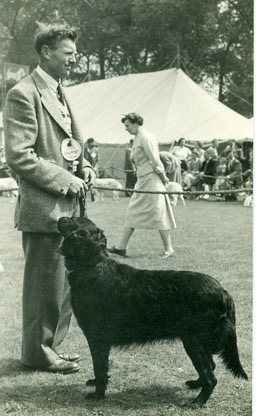
The litter mates Pewcroft Prefect (owned by Mrs and Mrs Downing in US) and Pewcroft Proper with owner Mr Read Flowers. Two early Pewcroft dogs showing a distinct Labrador character that might originate from the infusion of Labrador blood.

The repeated linebreeding to the Dancer of Riverside X Atherbram Jet combination gradually restored the beautiful classical Flatcoat type. Below Pewcroft Plug, owned by Mr and Mrs O’Neill.
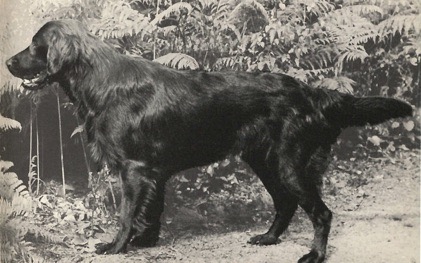
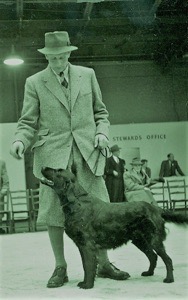
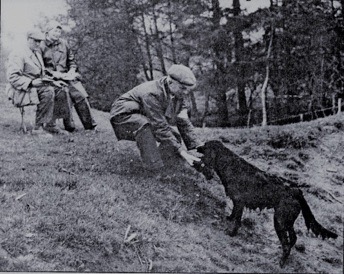
Mr. Harry Wilson and his great trialler Pewcroft Page
Claverdon Tawney Pippet
Looking backwards into my own Flatcoat history the very first Flatcoat we had in 1971, Dual Ch Tittie (look at flatcoatdata.com), had at least ten lines back to Plague. She was in no way unique but her drive, close hunting style, and working capabilities was in level with the best Labradors (although being a bit headstrong) and at the same time her looks were rewarded with CC’s by Colin Wells, Nancy Laughton and many other British judges.
It’s notable that a few more Interbreds were created openly in the post war Flatcoat stock. If I remember correctly one of Colin Wells dogs was used on a Scottish Interbred but I can’t find any trace of that in Flatcoatdata.com. Another interbreeding is the one between Amelia Jessel’s Collyers Blakeholme Brewster and two Scottish interbred littermates from mixed Golden/Flatcoat breeding in 1969. Even if the offspring was used in Britain and these lines can be traced behind the Bramatha and Belsud Flatcoats, I believe it had its strongest impact on the Swedish and Norwegian stock. Mrs. Lock (Halstock) used Ailsa Craig of Halkshill to produce Mimosa of Halstock for Sweden and Matilda of Halstock for Norway. Mimosa became a Nordic show champion and she was, no doubt, a very typical and good looking Flatcoat. She had a quite strong and positive impact on the Swedish lines and her grandson, Latchford Snobben, was the very first Swedish Flatcoat winning well and continuously on a group level. Another dog from the same line, Bramatha Copper Najinski, was imported by Ragnhild Ulin to Sweden, a nice workmanlike type of dog, that added a lot of outcross blood to the Swedish lines.
Today Interbreeding isn’t allowed but exceptions can be made in some countries for health reasons if the gene pool can be considered to be too narrow. An interbreeding initiative was taken in the Swedish Clumber Club 2003 when a Clumber bitch was mated to a working Cocker with a Clumber like coloring. In the third generation, their offspring was examined and considered to be typical Clumbers and in the following generation a couple of individuals were given CC’s by specialist judges. The initiative is a remarkable success and dogs from this line have been exported to several countries. A young dog has been used at stud in Britain. One of the most successful British working Clumber breeders have used him on a bitch that has been rewarded at any variety Field Trials and a young bitch out of that combination has copied the dam’s success. According to my contact at the Swedish Clumber Club the handler/owner consider her to be the best working Clumber he has ever experienced.
DNA analyses that have been laid out recently by the UC Davis Veterinary Genetics Laboratory in the US, shows that the Flatcoat has” the lowest level of breed wide genetic diversity that they have identified in any breed to date”. The tested population may still be limited as well as the number of breeds. But knowing the very limited original British breeding pool behind all worldwide Flatcoats today, I’m sure the statement will prove to be quite correct. Even if the original post war breeding stock had an excellent quality from most aspects and the founder breeders were the most competent, concerned and serious ones, a continuously narrowing genepool will have consequences. I’m sure DNA testing will be a crucial tool to counteract that and I believe the day will come when we realize that interbreeding must be another tool to improve the genetical diversity as well as to restore vanishing features in the working Flatcoated retriever.
Ingemar Borelius - Active in the Flatcoat world since 1971 and in the local breed club in Sweden. Being a passionate” amateur historian” has spent a lot of time over the years to study and to write about the breed history of which many of his articles can be found on the Flatcoated Retrieverklubben website as well as other personal webpages (Kennel Friia)